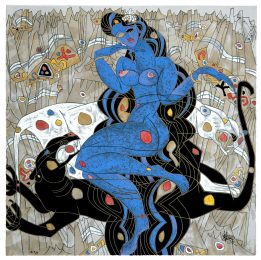

“My paintings are not only pictures; they are also music and poetry that is bewitching, sweet dreams that are being dreamed.”
Born in Zhejiang Province, China, Jiang discovered his love of art through painting and drawing during his early childhood.
After winning admission to the Central Academy of Fine Arts in Beijing, Jiang earned a Bachelor of Arts degree in 1964, just before the beginning of the Cultural Revolution.
On completion of his studies Jiang volunteered to visit the lush and tropical Yunnan province on the Vietnamese border. This visit to such an exotic landscape was to prove a lifelong influence on Jiang’s work.
The Chinese government also recognised Jiang’s talent and forced him to produce propaganda posters and sculptures as part of the Cultural Revolution, including the iconic red faced poster of Chairman Mao. At night though, Jiang was inspired by the natural beauty of the Yunnan province and he developed a style of his own. He was particularly focused on bringing colour to his art and, using the influence of Chinese mythology and Buddhism, he created pieces with great symbolic meaning. He and two other artists, He Neng and Liu Shaohui, secretly founded the “Yunnan School” where the use of bold colour and imagery was embedded in the teachings.
Jiang’s career was able to thrive, even under the harsh realities of the Cultural Revolution. In 1979 he was commissioned by the Chinese government to paint a mural representing the Yunnan province for the Great Hall of the People in Beijing. Jiang also illustrated children’s books and cartoons. Ultimately though, Jiang’s work fell out of favour with the communist government.
During 1982 a National Geographic reporter writing an article on life in China saw Jiang’s paintings. A selection was smuggled out of China, folded up in a National Geographic magazine, and brought back to the U.S. were they received high praise.
Jiang permanently emigrated to the U.S. in 1984 where his work has been shown in many public exhibitions including those at the Portland Museum in Virginia and the New England Centre of Contemporary Art.